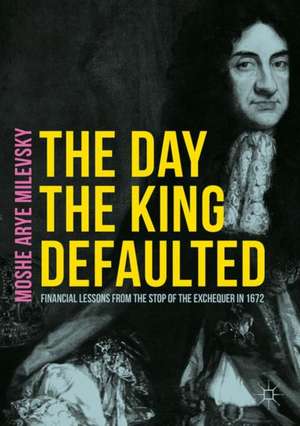The Day the King Defaulted: Financial Lessons from the Stop of the Exchequer in 1672
Autor Moshe Arye Milevskyen Limba Engleză Paperback – 2 oct 2017
Preț: 272.49 lei
Nou
Puncte Express: 409
Preț estimativ în valută:
52.15€ • 56.62$ • 43.80£
52.15€ • 56.62$ • 43.80£
Carte disponibilă
Livrare economică 01-15 aprilie
Preluare comenzi: 021 569.72.76
Specificații
ISBN-13: 9783319599861
ISBN-10: 3319599860
Pagini: 218
Ilustrații: XXI, 218 p. 23 illus., 17 illus. in color.
Dimensiuni: 148 x 210 x 25 mm
Greutate: 0.3 kg
Ediția:1st ed. 2017
Editura: Springer International Publishing
Colecția Palgrave Macmillan
Locul publicării:Cham, Switzerland
ISBN-10: 3319599860
Pagini: 218
Ilustrații: XXI, 218 p. 23 illus., 17 illus. in color.
Dimensiuni: 148 x 210 x 25 mm
Greutate: 0.3 kg
Ediția:1st ed. 2017
Editura: Springer International Publishing
Colecția Palgrave Macmillan
Locul publicării:Cham, Switzerland
Cuprins
1. Bankers Then and Now.- 2. Dramatis Personae.- 3. The Goldsmith-Bankers.- 4. Personal Finances of a King.- 5. Paid Upon Orders from the Treasury.- 6. Diary of a Default.- 7. Concluding Thoughts for the 21st Century.
Notă biografică
Moshe Arye Milevsky is Professor of Finance at the Schulich School of Business at York University, Canada. An award-winning author and scholar, he is an expert on the modern and historical intersection of insurance and financial products. He is also a very popular speaker who has delivered over 1,000 presentations around the world.
Textul de pe ultima copertă
This book studies King Charles II's decision to stop all payments from his royal exchequer, a sordid but little-known event in English history with eerie similarities to the cause of the Great Recession of 2008. As with any modern banking crisis, the financial system in 1672 almost collapsed, day-to-day commerce ground to a halt, houses were lost, and ordinary investors suffered – but there was no banking bailout, and no mercy for the goldsmith-bankers who had lent the king millions to fund his unsustainable lifestyle. The royal decision, made in the wake of plagues, fires, and war with the Dutch, left bankers unable to cover their own liabilities and, in the days before bankruptcy, they couldn’t walk away from their obligations and start fresh. Many bankers spent the end of their lives in debtors' prison, but English commoners had little sympathy for the plight of rich financiers – a sentiment echoed after the financial crisis of 2008. Ultimately, this book tells the complete story ofthe Merry Monarch's financial default (England's first and last) using the lens and language of modern financial products and markets. It covers the precarious history leading up to the infamous day in 1672, the intrigue surrounding the ‘stop’ – including those who traded on inside information beforehand – as well as the attempt by distressed creditors to gain financial restitution.
Caracteristici
Contrasts the financial instruments blamed for the banking crisis of 2008 with the crisis of 1672 Examines a financial incident that rivals the 1720 South Sea Bubble in economic importance Combines elements of financial and political history during Restoration England
